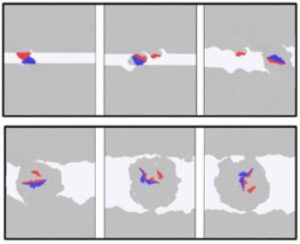Founder of TriboNet, Editor, PhD (Tribology), Tribology Scientist at ASML, The Netherlands. Expertise in lubrication, friction, wear and contact mechanics with emphasis on modeling. Creator of Tribology Simulator.
Adhesive Wear Particles Generation: by Fracture or Atom-by-Atom?

The most famous equation to predict wear known probably to everyone working in the field of tribology is Archard’s model (1953). The model assumes that wear occurs through the fracture of plastically deformed material and generation of wear debris. The fracture nature of the wear debris is backed up by a significant amount of experimental evidence of the wear particles (see also Small Particles – Big Impact). Recently, a different mechanism (it was theoretically predicted by Holm in 1946) was also observed in atomic force microscopy – an atom-by-atom wear. Molecular Dynamic (MD) simulations also predicted this mode of the wear process. However, the MD simulations also showed a gradual smoothing of the surfaces and subsequent cold welding, which is inconsistent with the experimental observation of sustained steady state wear.
The apparent contradiction of MD simulations with experiments was recently addressed by a team of researchers from Ecole Polytechnique Federale de Lausanne (EPFL). They showed for the first time that a fracture-induced debris formation at the asperity collision can be predicted using MD. Moreover, they found, that the transition from the atom-by-atom to the fracture based wear mode is controlled by the characteristic length scale of the adhesive junction. If the characteristic length scale of the adhesive junction is larger than the critical size, the fracture mode is encountered. Otherwise, smoothing, atom-by-atom wear occurs. The critical length is determined by the properties of the contacting solids.
The researchers developed a simple analytical model to discriminate the wear modes. The derived model is based on the minimization of the net configuration energy, so that the wear particle is formed when the fracture becomes more favorable over the strained junction in terms of energy. Specifically, the debris is generated if the elastic energy released due to particle formation is larger than the adhesive energy needed to debond asperities from the surfaces and form a new free surfaces on both solids. From this, an expression for the critical length was obtained.
A large amount of simulations was performed to cover a variety in the shape, size and number of asperities, material properties, boundary conditions, etc. Based on the obtained results, a very good agreement of the MD simulation and the analytical model was observed. Moreover, the proposed model was validated using experimental data available from the AFM measurements and an excellent agreement was reported.
It must be noted, that the developed model also allows to theoretically predict the probability of the wear particles formation, given that the distribution of the junction sizes is known (the distribution can be estimated using contact theories, for example asperity or half-space based contact models). This could be very helpful, since it would allow the use of Archard’s wear equation without a fitting parameter. The accuracy of the predicted value still has to be validated experimentally.
More details can be found in the original article by R. Aghababaei, D. H. Warner & J.-F. Molinari, “Critical length scale controls adhesive wear mechanisms“.
The image was edited from R. Aghababaei, D. H. Warner & J.-F. Molinari, “Critical length scale controls adhesive wear mechanisms“.
Leave a Reply
You must be logged in to post a comment.


“[T]he debris is generated if the elastic energy released due to particle formation is [greater] than the adhesive energy needed to debond asperities from the surfaces…”.
Two comments: 1. This is properly viewing the asperities interaction as an “energy transfer” event, with the outcome based upon the most thermodynamically favorable result. 2. Both models (Archard’s and Holms’) are really the same model when reduced to the nanoscopic level. Every interaction outcome is the result of the sum total of all the atomic level reactions of the interacting materials (both on the surfaces and subsurface). The discrepancies in the data come with the removal of the “thermo” from thermodynamics in crafting the equations and only considering the observed interactions on the macroscale and surfaces. “Damage” also occurs subsurface, and that damage is from the missing “thermo” side.
Yes, I guess they also tried to say the same. Their analytical equation is nice and simple, I will apply it to our simulations to find out the particle generation probability.